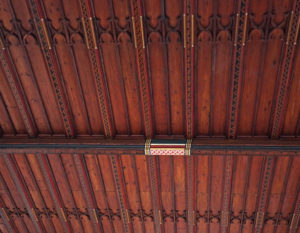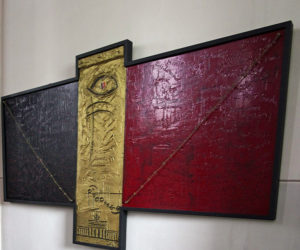The simple red stone building stands in the Market Place and is a functional rather than attractive church. with an interesting history. During the Siege of Kehl in 1793, both the Protestant and Catholic churches were destroyed. The State Government only gave permission for one church to be rebuilt which would serve both congregations. The Friedenskirche or Peace Church was built in 1817 on the fortress rubble. In 1914 it became the Protestant church after the building of the Catholic St. Johannes-Nepomuk.
The inside is equally plain and functional with its white walls. It is a rectangular building with an apse at the east end. It does feel rather a large, barn like building, possible as the apse just has a small altar with a few chairs round the walls. The cross on the east wall was given to the church and was originally a wayside cross from the Black Forest.
Possibly the most decorative part of the church is the wood roof with its carved panels and painted ribs. The windows in the nave are made up of geometric shapes of clear, grey and pale blue glass. They are unusual but very attractive. The font is also very modern.
The two large paintings on either side of the chancel arch were painted at the end of the C19th by the Munich painter Franz Rieger and are full of Gothic imagery. On the left is the Nativity. The arch has collapsed and the keystone is missing. Beneath is Christ in the manger who is described as the keystone of the Christian church. On the right and partially obscured by the organ, is the Ascension.
The church continues in its role of Peace Bringer and at the back of the south wall is a modern triptych entitled ‘Requiem for the Dead of the Berlin Wall’. It lists the names of those who died at the wall or along the frontiers of the DDR. The musical notes are the initial notes of Verdi’s Requiem.
The church is open daily and is worth popping into if passing.
There are more pictures “here.”:http://wasleys.org.uk/eleanor/otherholidays/rhine/d_kehl/friendskirche/index.html









